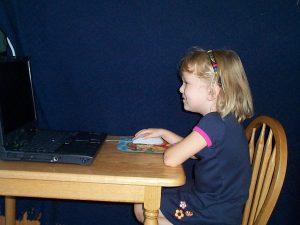In the spring, when we came home to work and study, most of us gave little thought to ergonomics. But as the months have worn on and computer use at home has become the norm, we really need to take a closer look. The photo above was taken many years ago – this child is now 23 years old! However, even today, most desks are not built for children. Actually, most home office desks are not even built for adult computer users! No one should work for more than a few minutes, with a mouse at shoulder height, or without a backrest of any sort. Over time, children experience the same aches and pains as adults. Sadly, children start sitting in front of screens much younger than we did, back in the “go-outside-to-play-until-dusk” days, and they’ll pay a price for these prolonged, slouched postures, in adulthood.
The same principles apply for both children and adults:
1. Try to position the mouse and keyboard at elbow height. (Elbow height is the height of the elbows when the arms are relaxed, resting against the sides of the body.)
2. Ensure that the feet are firmly supported on the floor or on a footrest.
3. Provide cushioned back support from the hips to the shoulder blades, including pronounced support for the lower back curve.
4. Position the screen so the top of the glass is approximately level with your eyes.
There are other guidelines, and even some exceptions, but if you can set up your workstation, and your child’s workstation, using these principles, you will work and learn more effectively!
When setting up a workstation for a child, consider using child-sized furniture. It’s very difficult to fit a child into an adult-sized chair and workstation. Even with adjustable furniture, the seat pan will be too deep, and you’d have to custom-build a very high footrest to make it work.
 The photo at right shows an improvement; she was happier, but I wouldn’t want her to work like this all day. The screen was still too high, the mouse was too big and too high, and the chair offered no cushioning and poor back support.
The photo at right shows an improvement; she was happier, but I wouldn’t want her to work like this all day. The screen was still too high, the mouse was too big and too high, and the chair offered no cushioning and poor back support.
This tip works for kids too:
Encourage children to find a good spot to stand to work occasionally during the day, if they are using a portable device. The “best” spot is at standing elbow height.
Ergo tip for home office workers:
Note the “apron” around the table shown above. Many dining tables are designed with this structure, which creates a “depth” to the table. Drawers under desks create the same problem. This depth creates a challenge for optimizing keyboard/mouse height:
– When you adjust the chair high enough to position the keyboard/mouse at elbow height, your thighs strike the bottom of the apron or drawers.
– Conversely, if you lower the chair to allow leg space, the keyboard and mouse will be too high.
If you’re looking for a comfortable work table around the house, try to find one that does not have drawers or an apron, so that you can optimise keyboard height while allowing leg space.
Need some help with your home office?
Check out our ergo presentation for home office workers, here which is still free for individual users, or request a home office ergo assessment, here.


